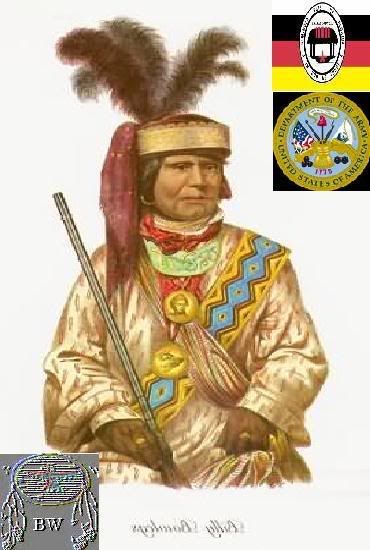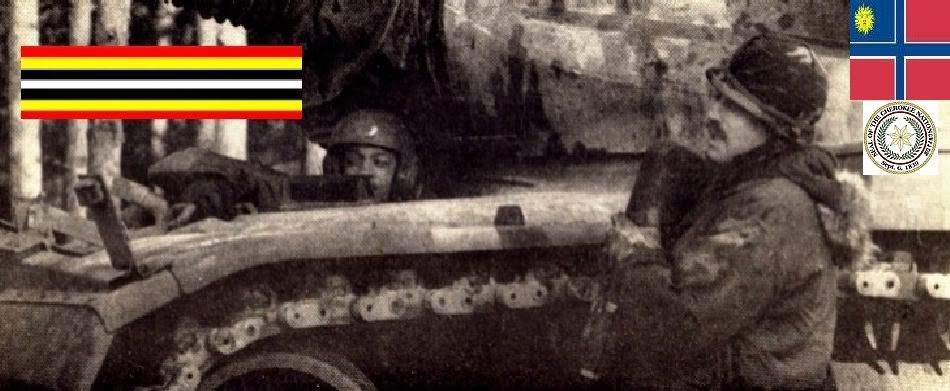|

United States Army Captain Chief Billy Bowlegs
(1810-1864)
Warriors Citation
Billy Bowlegs, a hereditary war chief (also known as Holata Mico, Halpatter-Micco, and Halpuda Mikko, all meaning "Alligator
Chief"), headed one of the last bands of Seminoles to stay in Florida and fight U.S. authorities. He was born in the Alchua
Savannah (present-day Cuscowilla, Florida) of full-blooded Seminole parents; his father was called Secoffee. It is said that
his nickname stemmed from Boleg or Bowleck, the surname of a prominent trader. The common assumption that he was bowlegged
from horseback riding cannot be substantiated. It is thought that Chief Micanopy was his uncle. Although he signed the Treaty
of Payne's Landing in 1832, Bowlegs subsequently avoided the removal of his band to Native American Territory for over twenty
years. He was known as a skilled warrior; to be sure, he eluded the U.S. Army long after Wild Cat's, Osceola's, and other
Seminole bands had been apprehended. Through an excellent knowledge of the Everglades, Bowlegs and his band maintained an
independent existence unhindered by U.S. authorities until the eve of the Civil War. From 1835 to 1842, Billy Bowlegs was
a significant leader in the Second Seminole War along with Arpeika, Osceola, Micanopy, Jumper, Wild Cat, and Alligator. Even
after the death of Osceola and the surrender of Micanopy, head chief of the Seminoles, in 1837, Bowlegs and his two hundred
warriors continued to resist removal to Indian Territory. On July 22, 1839, his name is mentioned in government reports relating
to an attack on a Camp Harney. This raid was one of a series of successful forays against the army and settlers by Bowlegs,
the new Chief of the Florida Seminoles. His guerilla tactics enabled him to secure, on August 14, 1842, a peace treaty that
ended over seven years of hostilities. This eight-year war cost the U.S. government $30 million and fifteen hundred dead.
To secure an enduring peace and impress Bowlegs and other Seminole chiefs with American might, a group of Seminole chiefs
were brought to Washington, D.C., to see the power of the U.S. capital. As a result, from 1842 to 1855 a period of relative
peace prevailed in Florida. However, a small group of army engineers and surveyors in 1855 invaded Bowleg's homeland in the
Great Cypress Swamp, stealing crops, cutting down banana trees, and destroying property only two miles from Bowleg's main
village just to see how he would react. This created what some have called the Third Seminole War. When the engineers and
surveyors were confronted about their depredations, they proffered the Seminoles neither restitution nor remorse. Consequently,
the Seminoles in southern Florida under Bowlegs launched two years of sporadic raids against Anglo trappers, settlers, and
traders in the area. Settlers demanded that the U.S. Army mount a campaign to remove all remaining Seminoles. Containing the
ravages of the Seminole militants once again proved difficult for the U.S. military. In 1858, a group of Western Seminoles
that were under the leadership of Wild Cat and that had been removed to Native American Territory were brought back to convince
Bowlegs and his followers of the wisdom of moving west. Bowlegs, upon hearing that Wild Cat was coming, stated, "Tell him
not to come out to our country until I send for him." Bowleg was offered $10,000 and each of his followers $1,000 if they
agreed to go to Native American Territory, but they initially refused, fearing harsh treatment in the West. Under enormous
pressure, Bowlegs and 123 of his followers, plus 41 captives, finally agreed to removal in 1858. After his arrival in the
West, Bowlegs became an important Seminole village chief in Native American Territory. At the start of the Civil War, he became
a leader of the pro-Union Seminole forces (the Loyal Seminoles); his unit fought on the Union side in Kansas.

As captain of the First Regiment, Native American Home Guard, Bowlegs served with distinction until he succumbed to smallpox
in 1864.From: historical accounts & records



LINK TO BRAVEHORSE WARRIORS VOLUME TWO
|

